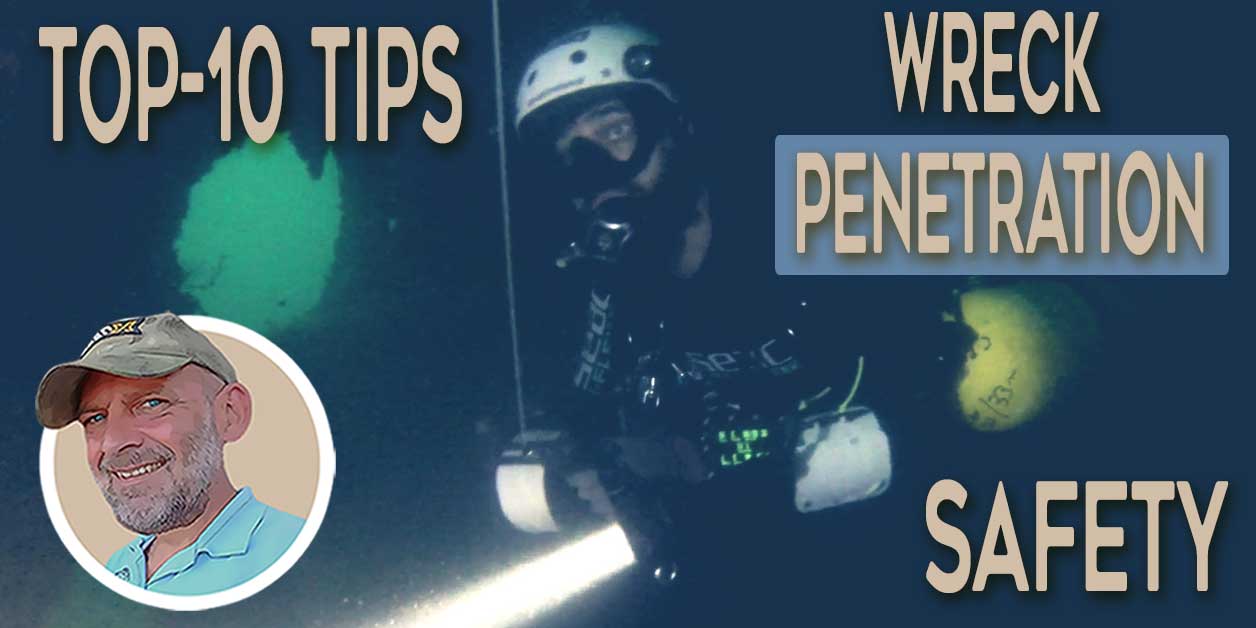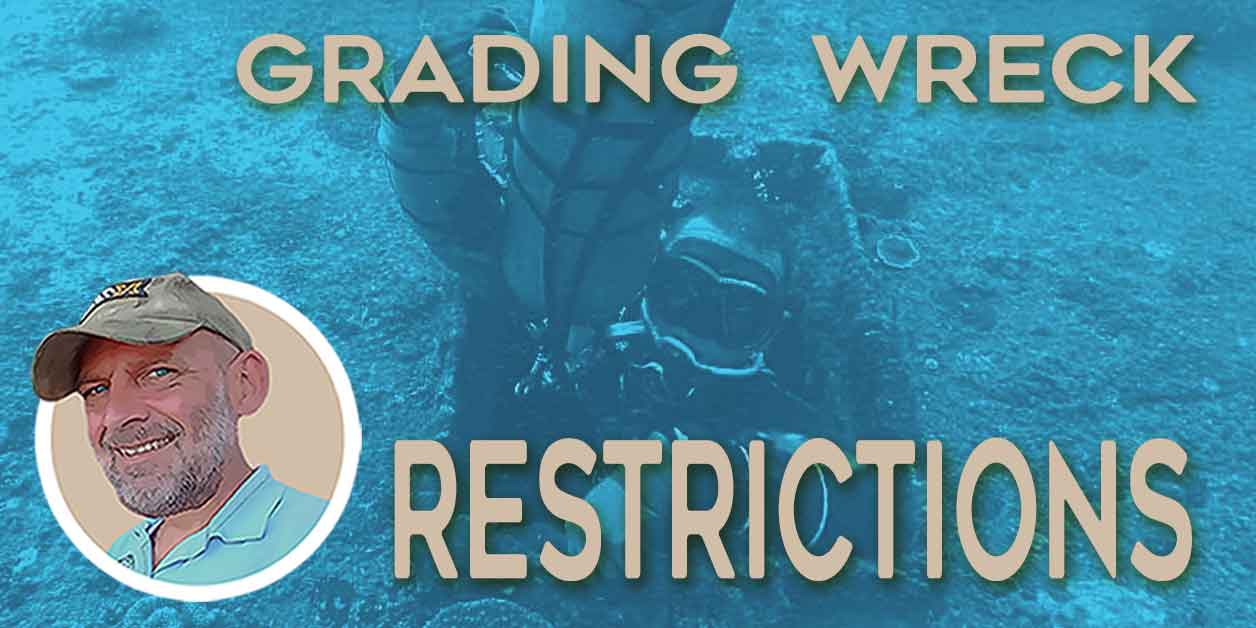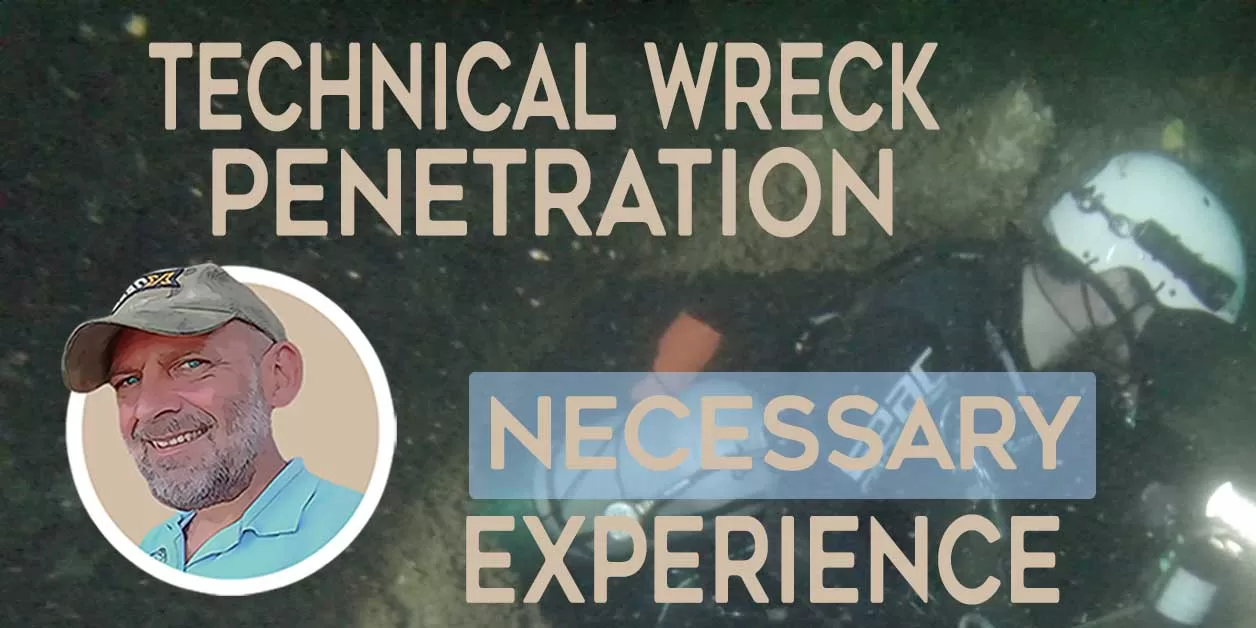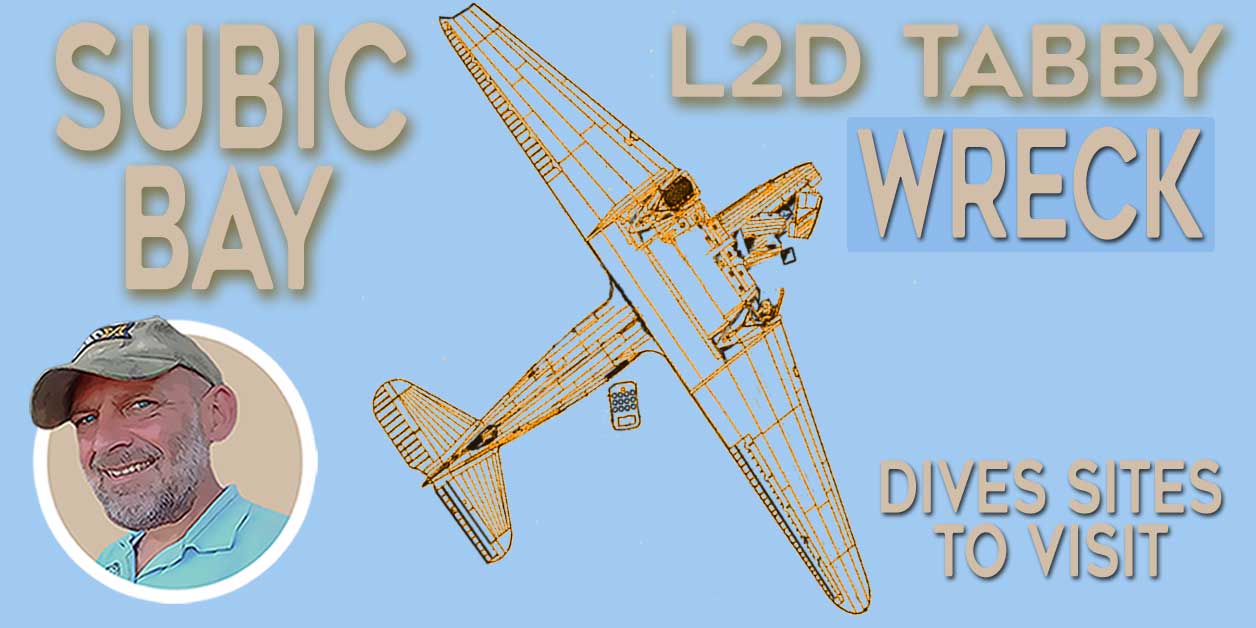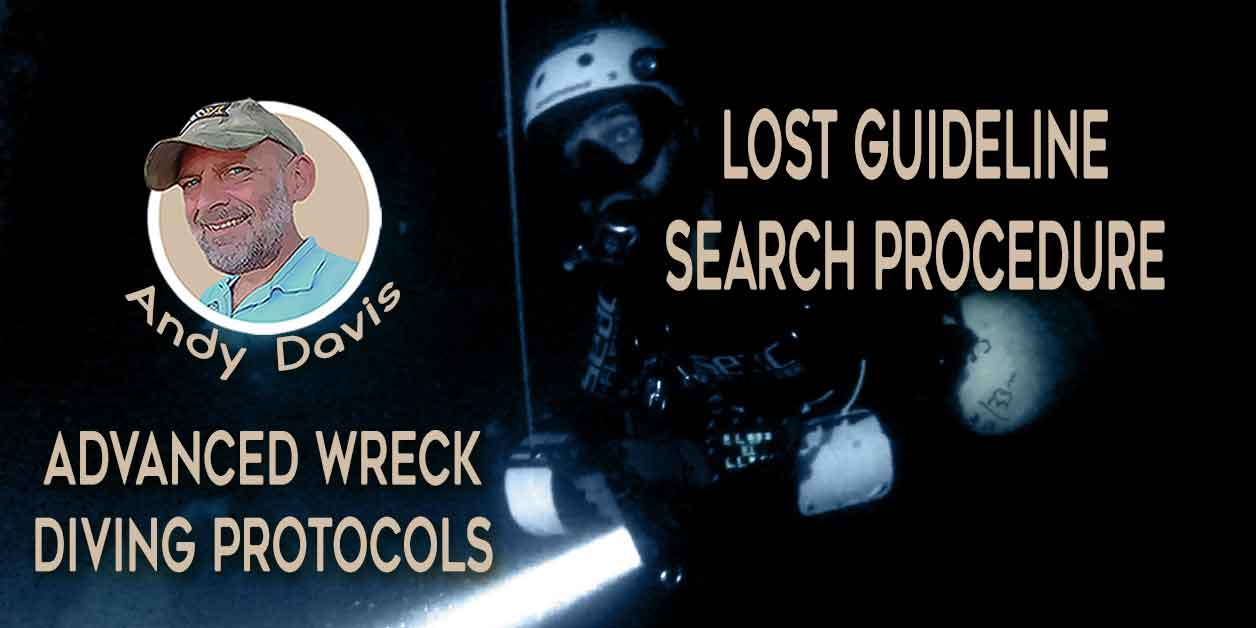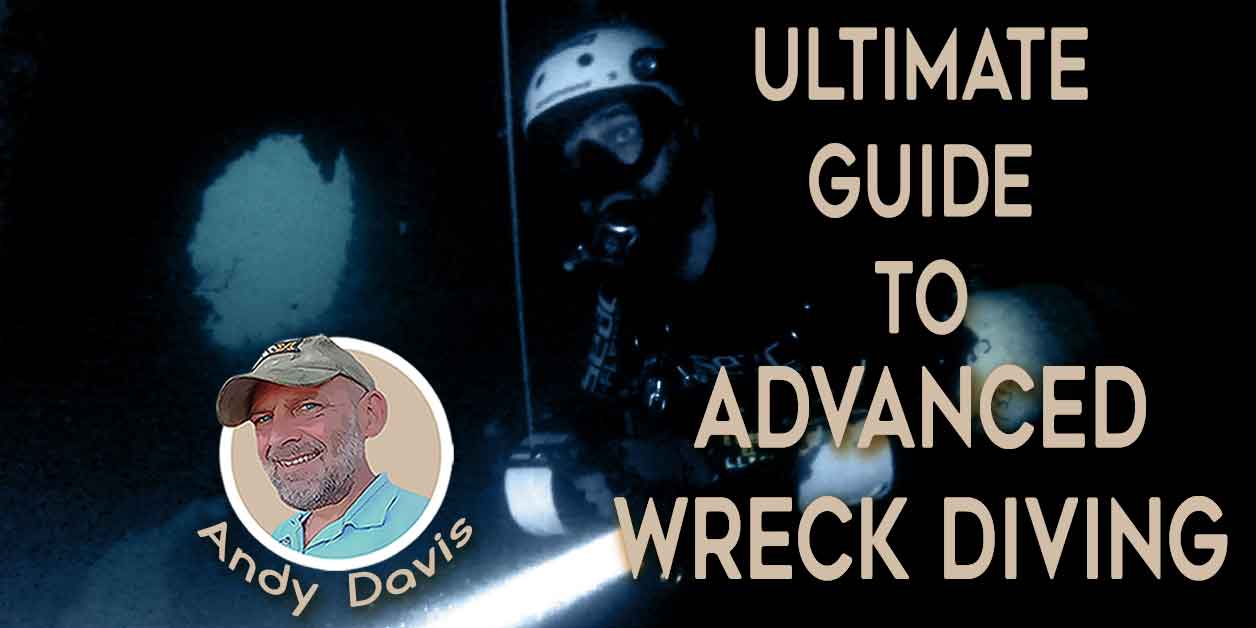Choosing A Wreck Diving Instructor: How To Find Legitimate Specialist Expertise!
In this article, I will be looking at what factors differentiate the best wreck diving instructor. Some wreck instructors fall dangerously short in competency. How important is legitimate specialist wreck diving expertise?
As a technical diving instructor with 3 decades of experience, I have learned harsh lessons about the hazards of wreck diving. It concerns me when wreck diver courses run by non-expert instructors do not deliver those life-preserving lessons.
I will explain how wreck diving can be similar, in both risks and required skills, to caves or caverns. How do the course syllabus and skills compare? What are the standards for wreck versus cave instructors?
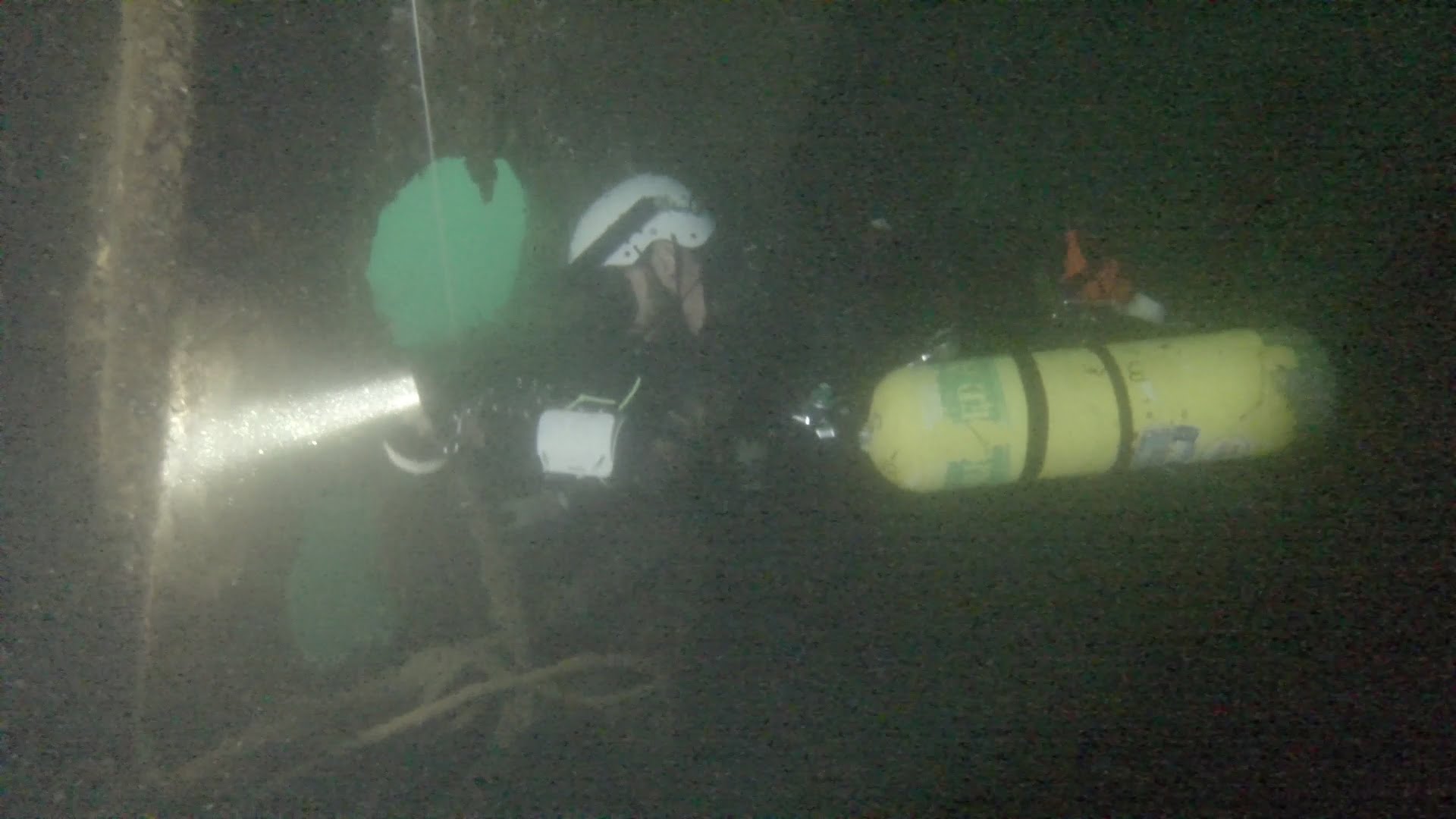
Overhead environments: cave, cavern, and wreck diving courses
Cavern and cave diving present similar risks to entering a shipwreck environment. However, wreck diving is not sanctioned by any official or specialist body.
Organizations like the NACD and NSS-CDS have always set a benchmark for cave-related training. In turn, this benchmark has typically been respected by mainstream scuba training agencies.
Access to cave systems is relatively easy to limit. This allows strict restrictions to be enforced. One such restriction is the need for approved training before entering an overhead environment.
No external regulation exists with wreck diving. Diver operators make their own rules. Those rules often prioritize profit, not safety. In most instances, scuba divers are at liberty to explore inside without suitable training, experience, or equipment. There is no mandatory use of guidelines, nor insistence upon effective equipment redundancy or team procedures.
Wrecks diving has no community benchmarks
Wreck diving has no such community-wide benchmarks. The mainstream scuba agencies have set a very low ‘bar’ on what it means to be a ‘wreck diver’. Divers are enabled to penetrate wrecks with meager overhead environment training. Often there are fewer than 2 dives training penetration-specific skills.
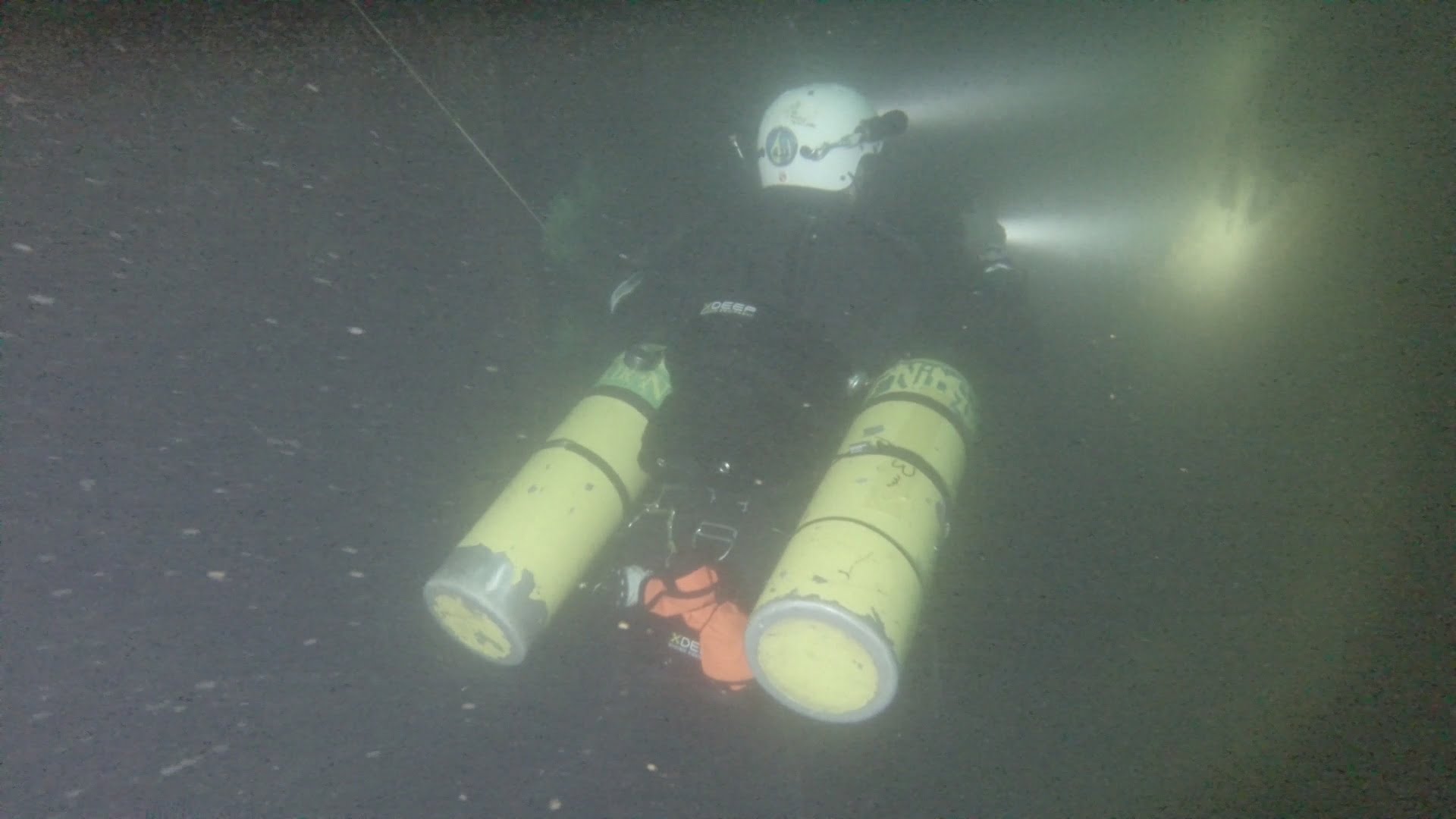
A cavern instructor must be a fully trained cave diver or instructor. In contrast, a wreck diving instructor might only have the most basic wreck diving experience. That can be as little as 25 dives, without ever having penetrated into a wreck. Unlike caver diving, some agencies allow their instructors to self-certify for teaching wreck. There is no assessment of competency involved.
Many wreck diving instructors have never actually laid a guideline inside a wreck when they are certified to teach. They have never experienced a silt-out or been entangled, They’ve never scared themselves after being disorientated to the exit. They may never have received a single day of professional instruction in wreck diving. That should scare people…

Overhead Environments – The Risks You Face
In scuba diving,an overhead environment is defined as:
- A scuba diving location where the diver does not have immediate access to the surface via direct ascent.
An overhead environment often appears safe to those uneducated about wreck diving risks. Seemingly benign, a mistake, or simply bad luck, can make an overhead environment deadly.
The danger with untrained wreck instructors is that they often ‘do not know, what they do not know‘. This prevents them from making a reasonable risk assessment for the penetration.. and gets them into trouble.
Cave diving agencies and divers devote an enormous effort to educating divers about the risks of caves. Remarkably little comparable education is given to recreational wreck diving instructors.
Wreck diving risks
Here is a summary of the primary risks involved with entering an overhead-environment. Wreck divers must be provided with complete knowledge and procedures to survive those risks:
- Failure of gas supply – through equipment malfunction, damage, negligence, or poor planning
- Disorientation – the inability to remember the way out
- Silt-out – disturbing silt, causing zero visibility and an inability to see the exit
- Lost buddy or team separation
- Collapse – the disintegration of an unstable structure that physically entraps divers or obstructs their exit
- Entanglement – with environmental objects or own guideline
- Entrapment – through a physical obstruction or water movement (current/surge) preventing exit
- Loss of weight belt – causing the diver to be pinned against the ceiling
- Explosion – wartime shipwrecks may contain unstable munitions and explosives
In essence, once you enter a wreck you lose the ability to surface on demand. You must exit first. There are a plethora of circumstances that can lead to you not being able to exit the wreck. Within the abrupt limits of your finite gas supply, that can be fatal.
Environmental causes: Factors such as current, visibility, surface conditions, and overhead barriers figure prominently as the triggering factors for fatal accidents. Many of these conditions are handled well by experienced, fit divers. For others, these same conditions lead to panic and actions that lead to death, not safety.
Scuba Diving: How High The Risk?, Journal of Insurance Medicine, Volume 27, No.1. by Nina Smith MD
The risks associated with overhead environment diving are highlighted within materials produced for the cave and cavern diving communities. Very little of that material is presented by wreck instructors to students on wreck diving courses.
The overhead environment safety message
This video, by Lamar Hires, a noted cave explorer, is watched by probably every student who enrolls in cavern or cave training. It is understood to be a necessarily serious message; presented to divers because of the well-understood risks. Risks that are substantiated by known trends in scuba accidents.
I’ve rarely seen an average recreational wreck diving instructor present this, or similar, materials on their wreck diver courses. That is a missed opportunity. Virtually every single point raised in this video is 100% applicable to diving inside wrecks:
Wreck Diving Courses – And Their Limits
In the excellent ‘Advanced Wreck Diving Handbook‘, famed wreck diver Gary Gentile differentiates wreck diving into three specific categories:
- Non-Penetration Diving – swimming outside and around the wreck
- Limited Penetration Diving – entering the wreck, but remaining within the “light zone”
- Full Penetration Diving – penetration without restriction; beyond the “light zone”
What is full penetration wreck diving?
Full penetration wreck diving is certainly the preserve of technical wreck courses. These courses are specifically focused on risk mitigation for wreck penetration dives
As such, training for this level of wreck diving demands an extremely high level of diving competence. The student needs to be a qualified technical diver. They must possess a proven skill set. A highly developed ability to control stress and retain mental functionality under the most severe circumstances is mandatory.
What is limited penetration wreck diving?
Limited penetration wreck diving includes any entrance into an overhead environment. The limitations applied to that penetration include:
- Remaining in the “light zone” – illuminated by ambient, external light and in visual sight of the (illuminated) exit
- Not passing through restricted/confined areas, where 2 divers cannot pass simultaneously, whilst sharing air
- Not entering areas of unreasonably high risk of silt-out or visibility degradation
This may shock you. In contrast to the clear definitions applied to cavern diving, wreck certifications do not differentiate between ‘limited’ and ‘no-penetration’ training.
Are wreck penetration training dives mandated?
Many mainstream dive training agency Wreck Diver specialty courses do not insist on actual wreck penetration dives being completed. You receive the same wreck diver certification regardless of whether you entered a wreck, or just stayed on the outside.
This inconsistency is illustrated in the PADI Wreck Diver course, which specifically states that students will:
Upon successful completion of the course, you will be awarded the PADI Wreck Diver Specialty certification. Certification means you’re qualified to:
Reference: PADI Wreck Diver Specialty Course Instructor Outline, Rev (5/05) Version 1.06
Make limited penetration dives into suitable wrecks, staying within the natural light zone and not penetrating more than 40 linear metres/130 linear feet from the surface.
There is no caveat that links that ‘qualification’ to the completion of the (optional) wreck penetration dive. Of course, that’s fine if you never intend to enter a wreck. However, many wreck divers do intend to explore wrecks. If not at first, then later on, as they gain more confidence. At that point, the nature and goals of their training become really critical.
Diving within the limits of your wreck training
One of the ‘5 Golden Rules’ of cave diving is:
“Be trained in cavern or cave diving and dive within the limits of your training.”
Given the stated similarities between wrecks and caves, this ‘golden rule’ is just as applicable to wreck divers. Possession of a ‘wreck diver’ certification card is not enough. We need to be honest about what specific training that certification actually represents.
It is the training, not the plastic card, that matters.
Read: Advanced Wreck Diving Guide
Wreck diving instructor credentials and experience
The first step to selecting the best wreck diving instructor is to consider their credentials and experience.
A wreck diving instructor offers far more training value if they are qualified above the level that they will teach. Consequently, you should look for a recreational-level wreck instructor who is qualified as a technical or advanced wreck diver. Technical wreck diving is generally on par with cave diving. It has a very similar skill set, protocols, and standards of tuition.
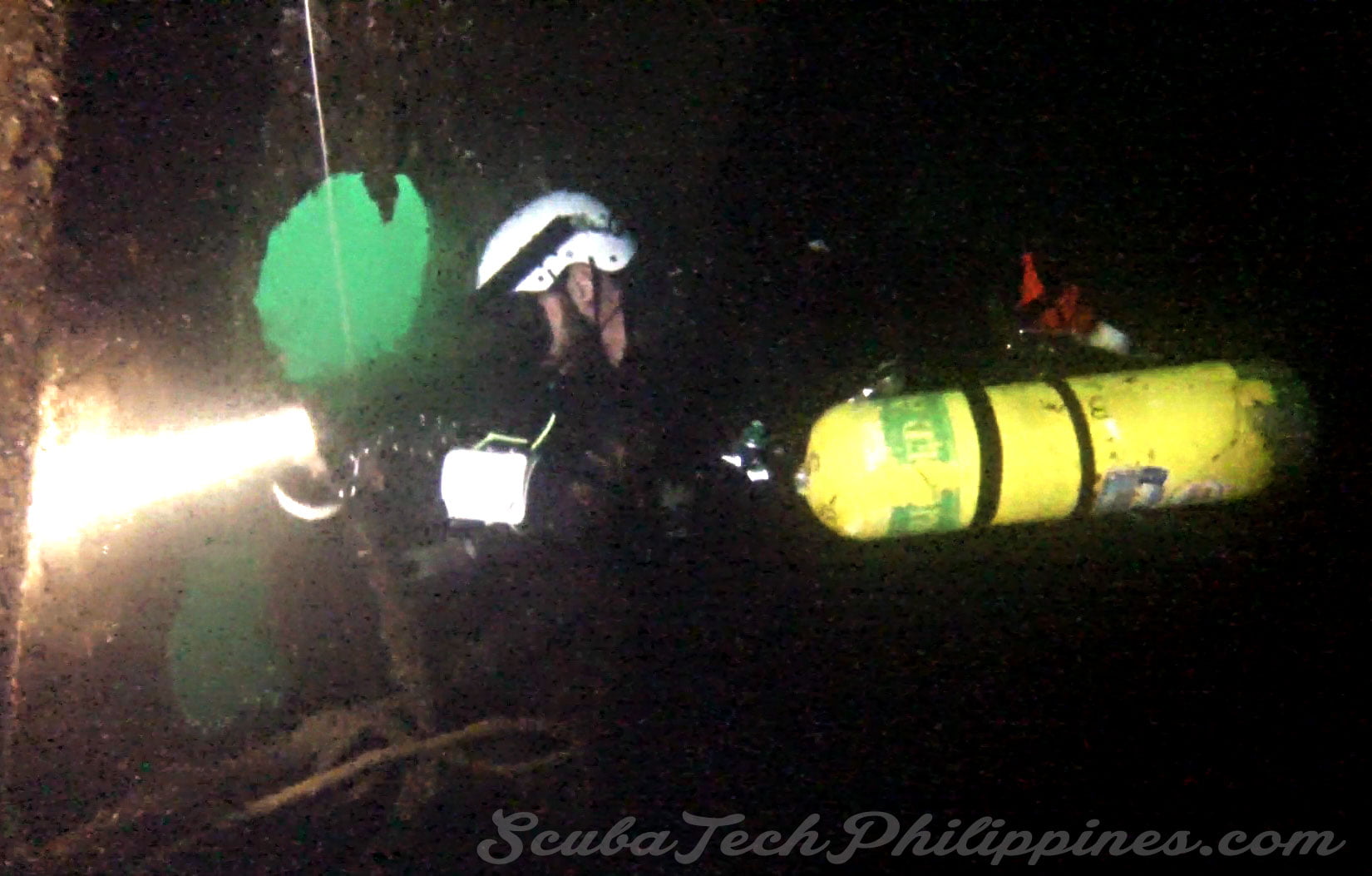
A specialist wreck instructor needs intensive training
Just about any ‘average Joe’ Open Water instructor can self-qualify as a wreck instructor. Swim around a sunken kayakk and it can be logged as a ‘wreck dive’. Repeat that twenty five times and get signed off to teach one of the most treacherous diving activites.
Many wreck diving instructors ‘pick up’ the wreck instructor rating because it’s known to be a ‘big seller’. Sadly, only a relatively small percentage of those instructors would honestly describe themselves as ‘experienced wreck divers’. Ask yourself… how can they honestly teach a subject that they have no breadth of experience in or passion about?
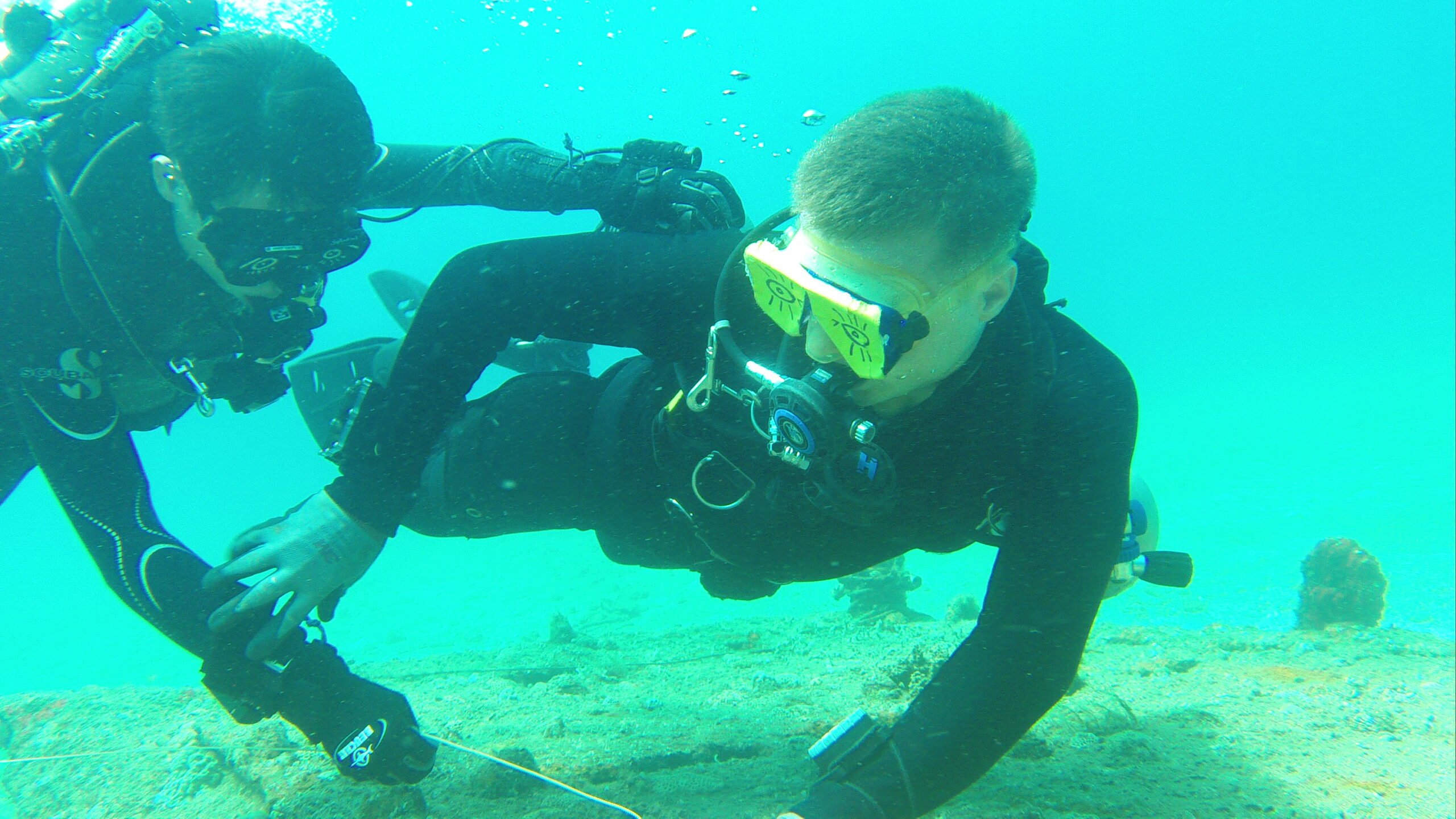
Is the wreck instructor passionate and motivated?
You should be investigating whether your potential wreck diving instructor is truly passionate and experienced in diving wrecks. Talk to the wreck instructor about it. Ask questions like:
- How many different shipwrecks have you dived upon? Where, when and how?
- Do you penetrate wrecks often.. and to what degree?
- What equipment and procedures do you use for penetration dives?
- What lessons have you learned from actual wreck diving, as opposed to course manuals?
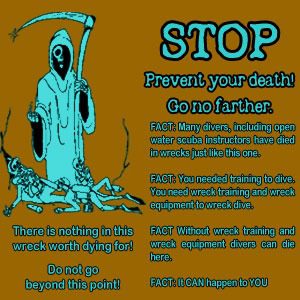
Wreck diving instructor location
This may sound obvious but a wreck diving instructor can only acquire meaningful experience and expertise if they are located in an area that offers very accessible and frequent wreck penetration diving.
As a wreck diving student, you need to complete training dives on reasonably sized wrecks if you are to become a competent wreck diver. Likewise, you need to complete meaningful penetration dives inside wrecks if you are to acquire effective wreck penetration skills.
You might be surprised to learn that few diving agencies actually define what a “wreck” is. It can be interpreted down to the point of ridiculousness, depending on how desperate an individual wreck diving instructor is to profit from selling wreck courses.
Good wreck diver training needs significant wrecks
I’ve literally seen wreck diver courses completed on sunken VW mini-vans, scaffolding structures, and worst, a sunken wooden kayak.
A wreck training site doesn’t need to be a huge shipwreck, but it does need to offer a meaningful experience for the fledgling wreck diver. If your goal is to become proficient in wreck penetration diving then you need to conduct meaningful penetrations under realistically challenging conditions.
Bear in mind that the (other) golden rule of scuba training applies in this instance: You are only qualified to dive in conditions under which you have trained. If you’ve trained diving on a sunken bus or small motor yacht, then there will be a significant experience deficit should you subsequently dive on/in a large shipwreck.
Select a wreck diving instructor in an area with accessible wreck sites
My honest advice is to research an instructor who operates in an area that offers convenient and regular access to ‘proper’ shipwrecks. Confirm what wrecks exist to be dived upon, and that you will actually be diving on those sites during your wreck diver course.
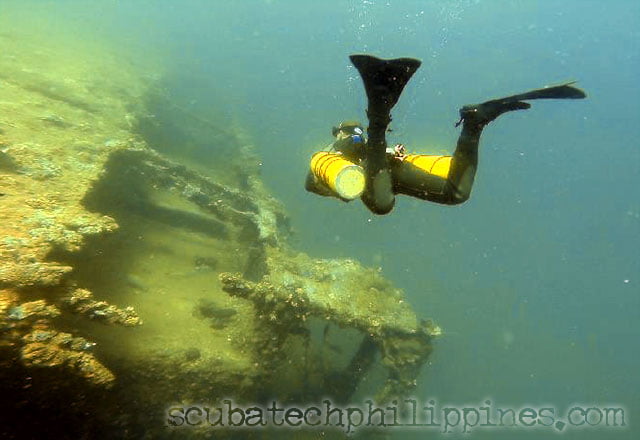
In many cases, it is worth deferring your wreck diver certification training until you have the opportunity to visit a truly ‘wreck-orientated’ diving location. Bad training can be more harmful than no training at all. Being patient until you have the chance to train with a legitimately expert wreck instructor is likely to pay long-term dividends in your safety, skill level, and experience.
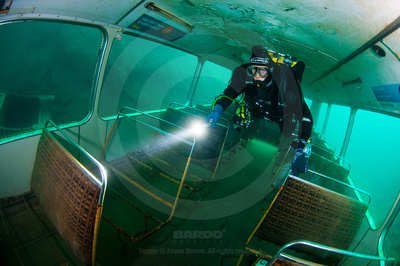
The wreck diving course structure
Finally, let’s examine the wreck diving course itself – what is taught, to what level of expertise, and what is omitted. In doing so, we must bear in mind the wreck diving hazards listed earlier; because those are the issues that need to be mitigated by the training provided.
When discussing training with a prospective wreck diving instructor, try to evaluate their approach to the course and what level of tuition will be provided.
Wreck appreciation and historical interest
Most entry-level wreck diving courses provide some theoretical knowledge on general issues surrounding shipwrecks. For instance, the legality of diving certain sites, the issue of artifact recovery, the historical and cultural significance of wrecks, and the preservation of marine ecosystems that often thrive around the ‘artificial reef’ that wrecks become.
This knowledge adds interest and flavor to a wreck diving course, but it does not contribute to the practical application of wreck diving skills or diver safety in the wreck environment.
Consider how this ‘wreck interest’ theory applies to the wreck sites you will be diving. It’s hard to substantiate ‘cultural and historical significance’ if your training dives are conducted on a mini-bus in a fresh-water lake.
Wreck navigation
A wreck diving instructor may offer an upgrade of basic scuba skills for the wreck environment. It is typical to repeat navigation exercises, as practiced on Open Water and Advanced Open Water courses, on wreck training dives; the use of the basic compass and natural navigation skills to ensure that divers can ‘return to the line’ at the end of the dive.
In truth, very little ‘translation’ of those skills is needed for the wreck environment. A compass is a compass. North is north.
A good wreck diving instructor will emphasize the need to research and understand wreck layout and structure, as the primary factor to ensure navigational awareness during the dive. They will educate divers about key features in ship design – and how those features can be identified on a dive and used to maintain an understanding of your relative location.
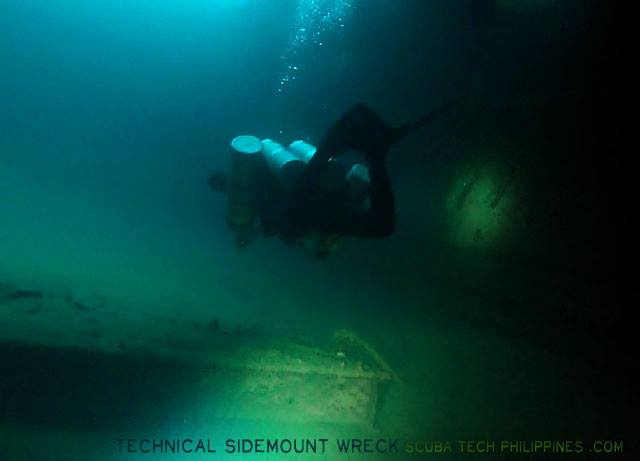
Wreck mapping exercises
Most wreck instructors also conduct a ‘map-drawing’ dive where the wreck students have to create a rudimentary wreck map. There are often different goals attributed to this exercise. The worst wreck diving instructors don’t consider how it can factor into wider wreck diving proficiency; they just tick a box en-route to handing out a certification card. Better wreck instructors use it as the basis to plan subsequent penetration dives. Others might use it to develop later research on the wreck – a technique that can help identify unknown or un-named wrecks you may, one day, encounter.
Performing wreck mapping in a meaningful way demands some education about ship features and layout. Some wreck diving instructors cover maritime terminology and ship design in a comprehensive way.
Wreck instructors and penetration training
Most recreational wreck diving instructors only provide a single dive to learn and experience actual wreck penetration. That is woefully insufficient to master wreck complex skills like reel and guideline use. A single wreck penetration dive simply doesn’t permit remedial feedback and the opportunity to improve and master techniques on further attempts.
As a bare minimum to allow any meaningful proficiency to develop, at least two wreck penetration dives are required. Without spending a meaningful amount of time inside a wreck, how can a wreck diver student be certified to:
“make limited penetration dives into suitable wrecks, staying within the natural light zone and not penetrating more than 40 linear meters/130 linear feet from the surface“.
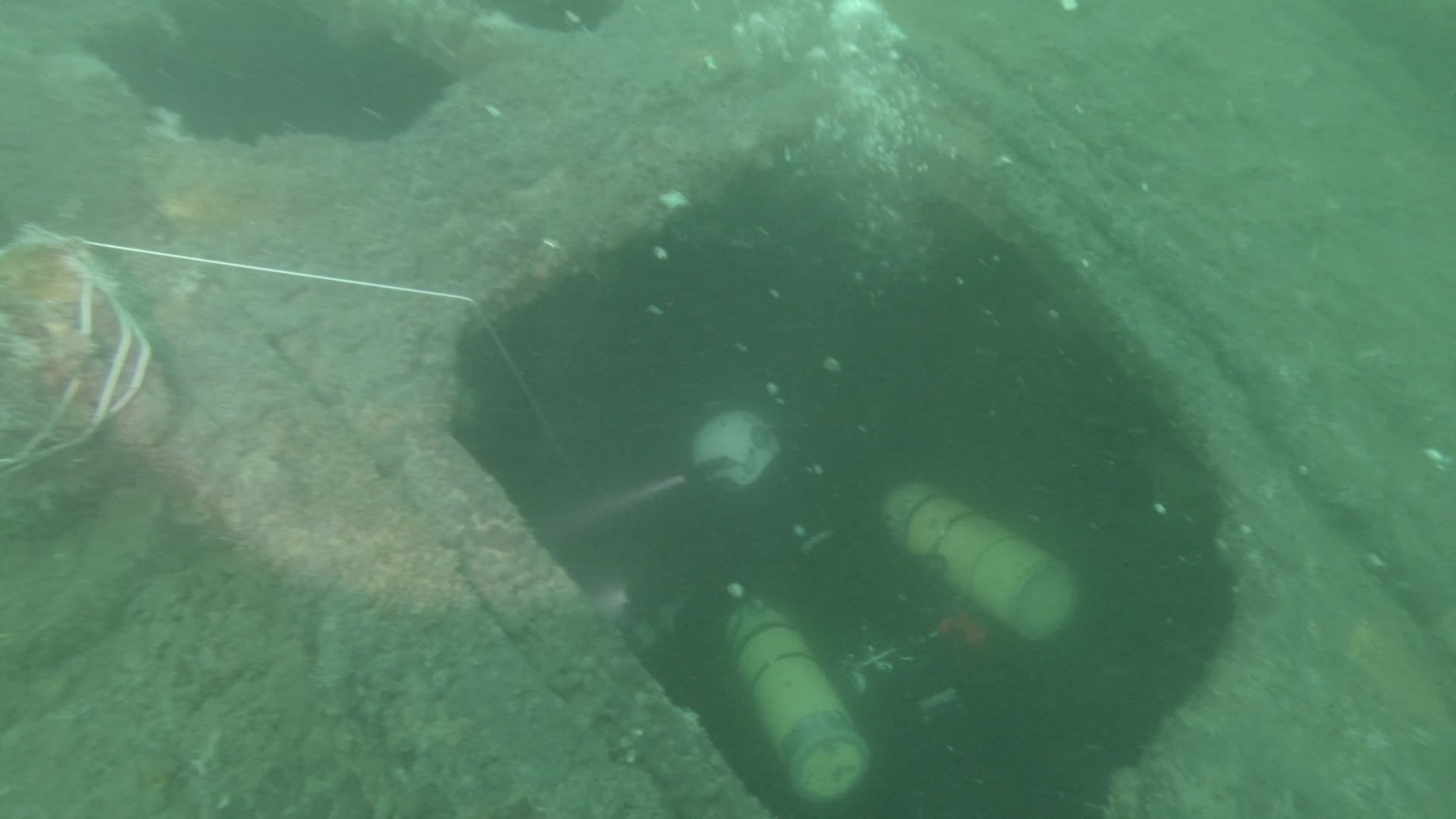
Two reasons why wreck instructors don’t perform penetration dives
I can only fathom two reasons why a wreck diving instructor would not conduct an actual wreck penetration dive during their wreck diver courses:
- The wreck diving instructor doesn’t have access to a dive site where penetration can actually be conducted. If so, are they really in a position to offer a ‘Wreck Diver’ qualification to the stated training expectations?
- The student is not confident or competent to conduct an actual wreck penetration – and either the instructor or the student themselves elect not to complete the optional penetration dive. If so, is it safe and responsible to issue that student a certification that states they are able to conduct wreck penetration dives?
It seems inexcusably irresponsible for a wreck diving instructor to certify a scuba diver as competent to penetrate wrecks if that diver has never been given the opportunity to demonstrate proficiency in that skill set.
Be sure to understand exactly how much emphasis your potential wreck diving instructor places on wreck penetration training during your wreck diver course. If it seems like an afterthought, an option, or merely a box-ticking exercise, then you should see that as a red flag warning.
Necessary wreck diving penetration skills
As I’ve discussed, wreck penetration is diving in an overhead environment. That environment poses specific hazards that need to be adequately addressed in training. When considering a wreck diving instructor, be sure to investigate exactly what wreck penetration skills they will teach you.
Based on the known wreck diving hazards, here are the proficiencies that I believe every safe and competent wreck diver should be capable of:
Buoyancy, trim, and propulsion
Silt-outs, entanglement, and entrapment are killers in the overhead environment. Every wreck diver needs a higher-than-average degree of buoyancy control, horizontal trim, and effective non-silting propulsion techniques. If these are not taught, then the diver is not able to mitigate against the most serious of wreck penetration hazards.
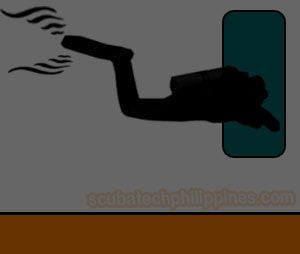
At a minimum, a wreck diving instructor should be teaching wreck students how to effectively utilize the ‘frog kick’ propulsion technique. A very high-caliber wreck instructor will go beyond this, introducing propulsion techniques that are typically only encountered at more technical levels – such as; the modified flutter kick, the modified frog kick, the shuffle kick, pull-and-glide, and finger-walking techniques.
Does a wreck diving course develop fundamental skills?
The wreck diving instructor should also spend time, on the introductory course dives, ensuring that the student has proper weighting, flat trim, and precise buoyancy control.
Where those core skills are deficient and likely to pose an unreasonable risk to the future wreck diver, the instructor should set aside training time on the wreck course to rectify foundational scuba diving skills.
This assumes, of course, that the wreck diving instructor themselves possess a high refinement in those skill sets. Whilst precision fundamental skills are rigorously honed in technical diving-level courses, they are not developed on any divemaster or instructor-level training course.
Don’t make assumptions about your potential wreck diving instructor’s capability to teach, or refine, fundamental diving skills to an overhead environment standard.
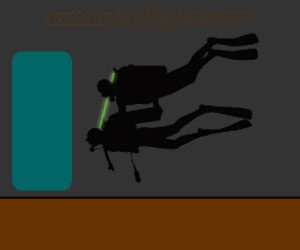
Air-sharing inside wrecks
Air-sharing is a critical scuba skill. When penetrating wrecks this skill takes an even greater emphasis because the wreck diver is unable to directly access the surface. There is little, or no, option for a Controlled Emergency Swimming Ascent (CESA). Without the fail-safe option of completing a CESA, the wreck penetration diver is absolutely reliant upon their buddy for air-sharing should they experience a problem with their gas supply inside the wreck.
Can you air-share through a wreck restriction?
Wreck divers should be counseled not to proceed into areas of the wreck that prohibit a simple air-sharing exit with their buddy. Divers have to be able to move side-by-side whilst sharing an alternate air source (octopus). Tight hatchways, doors, and other small spaces inside of a wreck often prohibit that. These tight spaces are known as wreck restrictions.
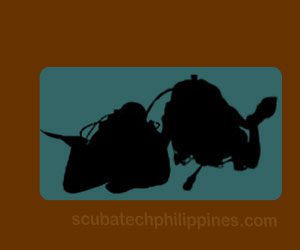
Air-sharing skills must be practiced on the wreck diving course. It is not sufficient to allow divers to ‘work this out doe themselves’ at a later date when a real gas emergency arises inside a wreck. If that happens, there will already be a high degree of stress and further adding to that psychological burden may prove sufficient to push a diver into a panic.
Inside wrecks, panic kills.
Weak diver skills and the risk of silt outs
At this time, we also need to consider the impact of ‘skill deficit’ relative to the other critical hazards common to wreck penetrations. If the wreck divers are struggling to establish an effective air-sharing technique for the confined space they find themselves in, then it is a high likelihood that the subsequent task-loading and necessary maneuvering will begin to stir up silt.
As the silt rapidly diminishes visibility, it adds further anxiety – and severely increases the danger of the situation. The divers are now out/low-on-gas…and may increasingly struggle to orientate to the exit. Like dominoes, one problem can easily lead to further complications.
Does the wreck diving instructor train in long hose use?
A competent wreck diving instructor will educate their wreck students about the benefits of ‘long-hose’ alternate air sources. The use of a long (5-7″) hose for air-sharing originates from the cave and advanced wreck diving.
A long hose permits wreck divers to continue sharing air, even if traveling through restrictions in single-file. There are specific techniques for stowing, deploying, and utilizing a long-hose air source. Even if not chosen as a personal solution, the wreck diver should be educated about those options.
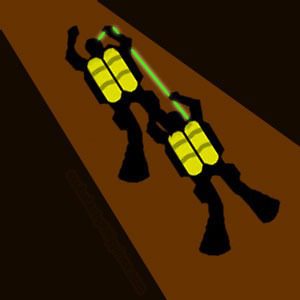
Guideline Deployment
It is critical to lay a guideline whenever entering an overhead environment. In his seminal work on cave diving safety and accident analysis, ‘Cave Diving: A Blueprint for Survival“, Sheck Exley summarized that “failure to lay a guideline” was one of the leading contributing/causal factors in overhead environment diving deaths. Laying a guideline is one of the ‘5 sacred rules’ for cave diving – and is equally applicable to wreck penetration.
Laying an effective guideline is an art. It is also an activity prone to risks – the biggest being that the diver themselves gets entangled in their own line. There are specific techniques and considerations for use of a guideline, and the wreck diving instructor’s expertise and knowledge are essential if these are to be taught properly and completely.
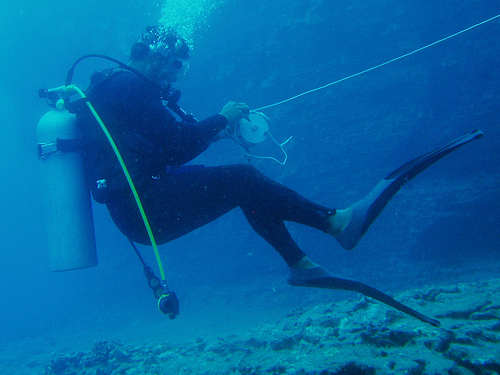
What guideline skills should a wreck instructor teach?
Ideally, comprehensive training on guideline deployment should include the following skills:
- The retention of buoyancy, trim, control and situational awareness whilst task-loaded with a reel and line
- How to perform a double tie-off outside the wreck
- How to create tie-offs and placements at appropriate intervals and locations as the penetration progresses
- The dangers of ‘line traps’ and how to avoid them
- Routing a guideline so that it can be easily followed to the exit in zero visibility
- The roles of the ‘reel diver’ and other team members
- Contingency procedures for a ‘cut/snapped’ line and a diver entangled in the line
- Maintaining appropriate tension on the line, during deployment and retrieval
- The use, selection, and storage of primary reels and safety spools
- The calculation of ‘turn-points’ based on precise gas management and accurate dive planning
It is advisable to discuss guideline-specific training with a potential wreck diving instructor. Confirm that they can, and will, provide all aspects of that training; because you will need it to mitigate the risks involved with wreck penetration.
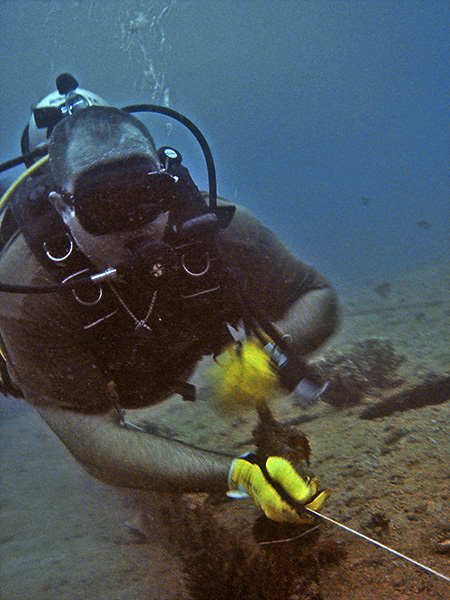
Wreck diving equipment considerations
Wreck penetration demands certain equipment configurations. A competent wreck diving instructor should be capable of advising you on equipment selection and modification. These considerations might include:
- Redundant gas supplies, their configuration and use – pony cylinders, doubles, and sidemount
- Effective lighting options and the use of 1-2 backup lights – another of Exley’s “5 Golden Rules”
- Streamlining your scuba equipment to reduce entanglement hazards
- Optimal fins for non-silting propulsion in confined environments
- Storage of, and access to, essential accessories and tools
- Cutting devices, their location for stowage, and critical factors for selection
- Regulator hoses, lengths, and hose routing
- Minimalism and the ‘Keep It Simple’ philosophy in relation to wreck hazards
Whilst that list is not exhaustive – the point being made is that a legitimately competent wreck diving instructor, will be able to work with you to optimally configure your equipment for wreck dives.
The wreck diving instructor’s willingness and ability to assist you with these important factors should be ascertained.
Zero-visibility training
The loss of visibility is the single biggest risk to the wreck diver. Most wrecks are full of silt and sediment – and a single ill-considered fin stroke may be sufficient to cause a silt out; a blinding cloud of silt that swallows all light and reduces the wreck diver to touch-feeling their way out of the wreck.
A competent wreck diving instructor will make sure that their students understand the implications of a ‘silt-out’ because most divers have difficulty comprehending exactly how debilitating this event can be.
Even the best-trained wreck divers can accidentally cause a loss of visibility. One should never be complacent or assume ‘it won’t happen to them’.
Even with a guideline in place, exiting a wreck in zero visibility is a time-consuming, stressful, and challenging proposition. For some, it is terrifying.
Wreck divers lay guidelines to mitigate against the known risk of silt-out and disorientation. Therefore, there is a logic that a proficient wreck diving instructor will want you to experience all applicable diving skills under those ‘blind’ conditions. Familiarity breeds comfort.. and, trust me, you won’t feel comfortable on your first exposure to reduced visibility inside a darkened shipwreck.
A good wreck diving instructor will familiarize you with silt
An exemplary wreck diving instructor will take the time to explain and practically demonstrate the ease with which silt can be disturbed. They will make sure you understand the differing properties of mud, sand, sediments, clay, etc.
They will highlight that silt-out can occur from elements of the wreck itself; rust flakes falling from the ceiling due to your exhaled bubbles, wooden structures disintegrating into a fine cloud of particles, disturbed containers or pipes giving off an underwater ‘smog’ of diesel or oil into the water.
Does the wreck diving instructor provide simulated zero visibility training?
A great wreck diving instructor should also drill you to operate under those conditions. That may include the use of a ‘blacked’ mask (blindfold) during repetitions of wreck diving course skills; such as guideline exits, air-sharing or entanglements. They might emphasize the need for team coordination under those conditions. They might even teach tactile hand signals and touch-contact communications to that end.
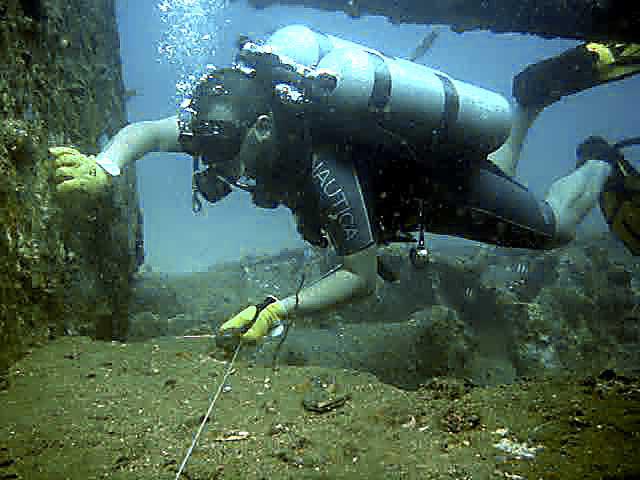
Those no-vision wreck drills are always challenging – most scuba divers underestimate how the loss of vision will detract from their ability to perform even the most simple and straightforward tasks underwater.
Quiz your potential wreck diving instructor on how he plans to train you to function in a silt-out. It’s important if you want to penetrate wrecks. Let no one tell you otherwise.
Finding the best wreck diving instructor
Hopefully, this discussion has helped you understand some of the issues involved with selecting the best wreck diving instructor, along with the experience, skills, procedures, and knowledge that should be provided on your wreck diving course.
Be under no illusions that wreck penetration diving is just as risk-laden as cavern diving. The training for those two environments should be of comparable quality; with an equal focus on safety and the development of critical techniques and knowledge.
Choose your future wreck diving instructor and course location carefully, based on diligent research and interviews.
Don’t be shy to ask a wreck diving instructor detailed questions and expect clear answers before booking. You need to confirm the ability of an instructor to deliver a high-quality wreck diving course.
Be wary of inexperienced or incompetent wreck instructors
It’s sad but true that many scuba diving instructors aren’t sufficiently experienced or trained to deliver what is, in essence, an advanced-level specialist environment course.
Be mindful that most wreck courses only consist of 4 training dives. These are the minimum requirements set by the training agency concerned. There is no maximum requirement – seek quality and focus on the results, not the certification card received.
Don’t just choose the cheapest wreck course
Choosing the quickest, most convenient, and cheapest wreck diving course is often proven to be a false economy, Such courses inevitably result in a woefully inadequate skill set and insufficient experience level for safe and proficient wreck penetration diving.
Experienced wreck diving instructors tend to offer training far beyond the bare minimum requirements. They will seek to provide a comprehensive wreck diving skill-set, rather than just completing a ‘tick-list’ of activities and handing out a certification card. The best wreck diving instructors do this because they know and understand what is required to be a safe wreck diver.
Wreck diving is only safe if you are expertly trained
Wreck penetration diving is only a very safe activity IF all the inherent risks are mitigated through effective training, adequate equipment, and the implementation of appropriate procedures. If a wreck diving instructor fails to provide their wreck students with the experience, knowledge, and competency to mitigate those risks, then they are failing to deliver what they promise – and that is short-changing the student at the expense of their safety.
About The Author

Andy Davis is a RAID, PADI TecRec, ANDI, BSAC, and SSI-qualified independent technical diving instructor who specializes in teaching sidemount, trimix, and advanced wreck diving courses.
Currently residing in Subic Bay, Philippines; he has amassed more than 10,000 open-circuit and CCR dives over three decades of challenging diving across the globe.
Andy has published numerous diving magazine articles and designed advanced certification courses for several dive training agencies, He regularly tests and reviews new dive gear for scuba equipment manufacturers. Andy is currently writing a series of advanced diving books and creating a range of tech diving clothing and accessories.
Prior to becoming a professional technical diving educator in 2006, Andy was a commissioned officer in the Royal Air Force and has served in Iraq, Afghanistan, Belize, and Cyprus.
In 2023, Andy was named in the “Who’s Who of Sidemount” list by GUE InDepth Magazine.
Purchase my exclusive diving ebooks!
Originally posted 2018-03-07 23:57:13.







